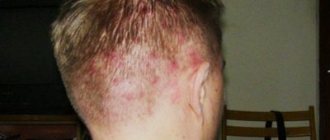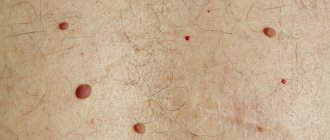What is uneven complexion
An uneven complexion can cause the following problems:
- age spots (pigmentation);
- spider veins (rosacea);
- rashes (acne, rosacea, seborrheic dermatitis);
- post-inflammatory spots;
- tired skin, “smoker’s skin”.
These signs can occur either individually or combined with each other, as, for example, in the case of photoaging of the skin. This problem is characterized by a “variegated” appearance due to numerous age spots, spider veins and skin atrophy.
Why does human skin color change?
The diversity of human appearance and form has intrigued biologists and beauticians for centuries, but nearly 100 years after William Bateson coined the term "genetics" in 1906, the genes underlying this diversity remain an unsolved mystery. One of the most obvious phenotypes that distinguish our species is differences in skin pigmentation. They are among the most mysterious.
There is a huge range of human skin colors, these may be related to climate, continents or cultures, but we know very little about the underlying genetic architecture. Is the number of common skin color genes closer to 5, 50, or 500?
Do gains or losses of function for a small set of genes lead to phenotypes at opposite ends of the pigment spectrum? Did natural selection influence similar pigmentation phenotypes independently of each other and along similar pathways? And should we finally care about the genetics of a person's pigmentation if it's just skin?
Why should we take care of our skin?
From a clinical point of view, insufficient protection from sunlight has a serious impact on human health. In Australia, the cumulative lifetime incidence of skin cancer approaches 50%, but the oxymoronic "smart tanning" industry continues to grow and there are conflicting opinions about the extent to which different types of melanin influence susceptibility to ultraviolet (UV) radiation.
At the other end of the spectrum, inadequate exposure to sunlight leads to vitamin D deficiency and rickets. It was cured thanks to advances in nutrition made in the early 19th century. In both cases, understanding the genetic architecture of human skin color will likely provide greater insight into the underlying biological mechanisms, internal organs, and blood vessels. And it may also be that mutational hotspots in the TP53 gene helped educate the public about the risks of tobacco.
From a basic science perspective, changes in human skin color provide an unprecedented opportunity for cell biologists, geneticists, and anthropologists to learn more about the biogenesis and movement of subcellular organelles. To better characterize the relationship between genotypic and phenotypic diversity, to further explore human origins and understand how recent human evolution may have been shaped by natural selection.
How does skin color change?
Historically, the measurement of human skin color has been based on subjective categories, such as "medium brown, rarely burns, tans very easily." More recently, quantitative methods based on reflectance spectrophotometry have been applied, which allow for redness caused by inflammation and increased hemoglobin. To be distinguished: from darkening caused by increased melanin content
As a factor - Melanin
Melanin itself is an organic polymer built from oxidative derivatives of tyrosine and comes in two types: a cysteine-rich red-yellow form known as pheomelanin and a less soluble black-brown form known as eumelanin. Distinguishing between pigment types in biological samples requires chemical extraction, but is worth it as we know little about common changes in human pigmentation, including switching pigment types.
Characteristic light skin type
The characteristic phenotype of fair skin, freckles, and wheaten-red hair is associated with high amounts of pheomelanin and low amounts of eumelanin and is caused by loss of function alleles in one gene, melanocortin 1 receptor (MC1R). However, MC1R variation has a significant effect on pigmentation only in populations where red hair and fair skin are common, and its main effects—stimulating eumelanin synthesis at the expense of pheomelanin synthesis or vice versa—contribute little to changes in skin reflectance between or between major ethnic groups.
Changing pigment for different skin types
More important than the ratio of melanin types is the total amount of melanin produced. In addition, the histological characteristics of different skin colors provide some clues as to the cellular mechanisms that likely lead to pigment changes. For the same area of the body, people with light and dark skin have the same number of melanocytes (there is a significant difference between different areas of the body), but pigment-containing organelles called melanosomes are larger, more numerous and more pigmented in dark compared to light skin. skin, which corresponds to individuals whose recent ancestors were from Africa, Asia or Europe.
In this view, oxidative enzymes such as tyrosinase (TYR), which catalyzes the formation of dopaquinone from tyrosine, or melanosomal membrane components such as pink-eyed dilution protein or membrane-associated transport protein (MATP) influence substrate availability . and TYR activity are logical candidates that genetic variations may contribute to the diversity of human skin color.
Equally important is what happens inside melanocytes and what happens outside. Each pigment cell actively transfers its melanosomes to approximately 40 basal keratinocytes; Ultimately, skin reflectance is determined by the number and distribution of pigment granules in keratinocytes rather than melanocytes.
In general, melanosomes in African skin are larger and more widely dispersed than in Asian or European skin. Notably, keratinocytes from dark skin cultured with melanocytes from light skin induce a melanosome distribution pattern characteristic of dark skin and vice versa. Thus, at least one component of skin color change is a gene or genes whose expression and action influence the environment of the pigment cells rather than the pigment cell itself.
The genetics of skin color
For any quantitative trait, with many contributing factors, the most important questions are: overall heritability, the number of genes that may be involved, and the best strategies for identifying those genes. For skin color, heritability in the broad sense (defined as the combined influence of genetic and nongenetic factors) is very high, provided that the most important nongenetic factor, exposure to sunlight, can be controlled.
Statements about the number of human skin color genes refer to several studies; one of the most complete is Harrison and Owen (1964). In this study, skin reflectance measurements were obtained from 70 residents of Liverpool whose parents, grandparents or both were of European ("with a large Irish component") or West African ("mainly from the coastal areas of Ghana and Nigeria") origin and who were roughly classified into "hybrid" and "reverse" groups on this basis.
An attempt to separate and analyze the variance of backcross groups resulted in minimal estimates of three to four “effective factors,” in this case independently separating genes. Aside from the keyword-minimal (Harrison and Owen's data could also be explained by 30–40 genes), one of the most interesting findings was that skin reflectance appeared to be largely additive. In other words, the average skin reflectance of the "F1 hybrid" or "inverse hybrid" groups is intermediate between their respective parent groups.
An alternative approach to considering the number of potential human pigmentation genes is based on mouse coat color genetics, one of the original models for identifying and studying gene action and interaction, for which nearly 100 different genes have been identified.
Leaving aside mouse mutations that cause white patches or predominant effects outside the pigment system, there remain no more than 15 or 20 mutations, many of which have been identified and characterized and most of which have human homologues in which null mutations cause albinism.
This brings us to the question of candidate genes for skin color, since, as with any quantitative trait, a reasonable place to start is with rare mutations known to cause extreme phenotypes, in this case Mendelian forms of albinism. The basic assumption is that if a rare null allele causes complete loss of pigment, then a set of polymorphic, i.e., more frequent alleles, with subtle effects on gene expression, will contribute to the spectrum of skin colors. The TYR, P and MATP genes discussed earlier are well known causes of albinism, the main effect of restricted pigment cells; Among them, the P gene is highly polymorphic, but the phenotypic consequences of P and gene polymorphisms are not yet known.
Regardless of the phenotype, the gene responsible for selecting for different skin colors should exhibit a population signature with a large number of alleles and rates of sequence substitution that are greater for nonsynonymous (which change an amino acid in a protein) than synonymous (which do not change any amino acid) changes. Data were collected only for MC1R, in which the most notable finding is the lack of allelic diversity in African samples, which is remarkable given that polymorphism for most genes is higher in Africa than in other geographic regions. Thus, while MC1R sequence variation does not significantly contribute to human skin color variation worldwide, functional MC1R is likely important for dark skin.
Selecting skin color
The primacy for describing the relationship between latitude and skin color in modern humans is usually attributed to the Italian geographer Renato Basutti, whose widely reproduced "skin color maps" illustrate the correlation of dark skin with equatorial proximity. Later research by physical anthropologists confirmed and expanded these observations; a recent review and analysis of data from more than 100 populations found that skin reflectance at the equator is lowest, then gradually increases, about 8% at 10° latitude in the northern hemisphere and about 4% at 10° latitude in the southern hemisphere. This pattern is inversely correlated with ultraviolet radiation levels, which are higher in the southern than in the northern hemisphere. An important caveat is that we do not know how UV exposure patterns have changed over time; More importantly, we don't know when skin color likely changed, with multiple migrations out of Africa and extensive genetic exchange over the last 500,000 years
Despite this, most anthropologists agree that differences in ultraviolet radiation caused the choice of dark skin in humans at the equator and light skin in humans at higher latitudes. This remains controversial. The most popular theory states that the protection provided by dark skin from ultraviolet radiation becomes a disadvantage in more polar latitudes due to vitamin D deficiency (Murray, 1934). UVB (short-wave UV) converts 7-dehydrocholesterol into an essential precursor of cholecaliferol (vitamin D 3)); When dietary supplementation is not otherwise provided, vitamin D deficiency causes rickets, a characteristic growth pathology and bone deformities.
An often-cited anecdote in support of the vitamin D hypothesis is that Arctic populations whose skin is relatively dark given their latitude, such as the Inuit and Sami, Chukchi and Eskimos, ate diets rich in vitamin D. The sensitivity of modern humans to vitamin D deficiency is evident from -due to the widespread prevalence of rickets in industrial Europe in the 19th century, but whether dark-skinned people migrating to the polar latitudes tens or hundreds of thousands of years ago encountered such problems remains in question! In any case, the risk of vitamin D deficiency can only be explained by choosing light skin. The most reliable protection against sunburn and skin cancer is due to the physical barrier created by epidermal melanin.
Solving the mystery of pigmentation
Recent developments in several areas present an exciting opportunity to better understand the diversity of human pigmentation. Improved spectrophotometric tools, advances in epidemiology and statistics, multiple genome sequences, and efficient methods for analyzing sequence variations give us the opportunity to replace misunderstandings and myths about skin color with a scientific approach.
The same approaches that have been used to study traits such as hypertension and obesity—genetic and association studies—can be applied in a much more powerful way to study human pigmentation, since the sources of environmental variation can be controlled and we have deeper knowledge of the basic sciences: biochemistry and cell biology.
This approach is particularly attractive given the dismal success rate in molecular identification of complex genetic diseases. In fact, knowledge of the genetic architecture of skin color may be useful in designing studies of other quantitative traits.
Current debates in the human genetics community include strategies for selecting populations and candidate genes to study the characteristics of polymorphisms that should be considered as potential disease mutations and the extent to which common diseases are caused by common (and presumably ancient) alleles. Although the specific answers will be different for each phenotype, there may be common themes and some answers are better than nothing.
Harrison and Owen concluded their study of human skin color in 1964, stating: "The shortcomings of the data in this study are highly appreciated by the authors, but since there is no opportunity at present to improve the data, it seems warranted to analyze it as far as possible." Almost 40 years later, possibilities are opening up and the mystery of human skin color may be solved.
Causes of uneven complexion
While the problem of dilated blood vessels and rashes may be genetically determined, one of the main causes of pigmentation is excessive sun exposure. Sunlight, namely the ultraviolet part of its spectrum, contributes to the appearance of pigmentation, dilated blood vessels and accelerated aging.
But it’s not just sunlight that causes skin changes: in some cases, it’s caused by excessive stress. For example, you fell asleep in the sun in the tropics, actively visited the solarium, or did a medium peel at the wrong time and in the wrong place.
Any injury instantly mobilizes skin resources: melanocytes are activated to produce melanin. This pigment acts as a protective shield, preventing potential skin breakdown. In addition, the body triggers the formation of new blood vessels in the skin to speed up metabolic processes, supply damaged skin with “building material” and remove destruction products.
An annoying problem can be a dull, sallow complexion, which is caused by impaired microcirculation as a result of spasm of the superficial vessels of the skin. This condition occurs due to a deficiency of vitamins, microelements, oxygen, sleep, as well as chronic exposure to nicotine.
Procedures to improve skin color
How to improve complexion? In salons today, many procedures are carried out, and among them there are some that correct skin tone and eliminate its dullness. And many experts say that such procedures are distinguished by their effectiveness. There are certain limitations and indications for each technique. Therefore, you first need to study the cause of the skin color disorder, and then only think about treatment. Cosmetologists recommend performing the following procedures to improve skin tone:
- mesotherapy. Here the cells are filled with nutrients. Injections are made into problem areas and the drug is administered. As for the medicine, it depends on the disorder itself, its type;
- chemical peeling. This method of skin correction is considered very effective. Special preparations are applied externally, causing a chemical burn, which can vary in intensity. Even if the treatment is superficial, the result of the procedure will be different. The skin of the face will be smooth, elastic, toning, and will have an even tone. But this procedure needs to be done by professionals to avoid serious consequences;
- laser peeling. It already uses a laser that does the job accurately. It will help get rid of age spots, brown, dull complexion;
- face massage. This procedure is characterized by normal perception and safety. It allows you to improve skin tone, remove skin unevenness, regenerate tissue, stimulate blood circulation;
- other procedures. They also carry out plasma lifting, photorejuvenation, biorevitalization, etc.
Gray complexion can be removed using ultrasonic facial skin cleansing. It has proven its effectiveness. But it is worth remembering that all of the listed procedures should be performed exclusively by specialists.
Cosmetics
One of the most important methods for preventing and correcting skin imperfections is properly selected skin care. Calm active melanocytes, strengthen the vascular wall, accelerate the exfoliation of altered cells - this is the task of modern cosmetics.
Unfortunately, not every product can deliver active ingredients into the deep layers of the skin - it is important to choose products from the cosmeceutical group that actually work. The ideal solution could be the Australian cosmeceutical brand Ultraceuticals, recognized by cosmetologists around the world. In addition to skin care and treatment products, the line includes the world's best photoprotection products, without which it is impossible to imagine an even complexion and youthful skin.
How to improve your skin tone?
There are standard recommendations that will help remove unhealthy complexion:
- you need to undergo a medical examination to determine possible diseases that could provoke this problem;
- carry out treatment that should be prescribed by a doctor;
- lead the right lifestyle, it should be active;
- Get enough sleep. This should be at least 6 hours per day;
- eat the right food - more fresh foods, less pickled, fried, fatty flour, drink clean water and plenty of it;
- exercise;
- walk in the fresh air, ventilate the room;
- do not use a lot of contraceptives, antibiotics;
- avoid stressful situations;
- try quitting smoking and drinking less.
These are the main activities that will help improve your skin tone and help your skin heal.
Brittle nails and hair loss
Strong nails and thick hair are definitely a sign of health. If your nails are brittle and your hair is falling out, this may indicate a lack of vitamin D. Most people in our latitudes who take a blood test have a decrease in the level of the “sun vitamin”. In addition, brittle hair and nails indicate an unbalanced diet, deficiency of proteins and fats of animal origin. Therefore, first of all, if you have problems with nails and hair, you need to reconsider your diet and start taking vitamin D 4000-5000 IU per day.
Hair loss also signals a disruption in its nutrition due to compression of the vessels that supply blood to the hair follicles. Because of this, bald patches form on the sides of the forehead, which reach the top of the head, i.e., it is into these areas that blood flows the most difficultly.
Article on the topic
The smell of illness. What does the body smell like with this or that pathology?
Sources
- Abdolahi M., Doustmohamadi MM., Sheikhbardsiri H. The Effect of an Educational Plan Based on the Roy Adaptation Model for Fatigue and Activities of Daily Living of Patients with Heart Failure Disease. // Ethiop J Health Sci - 2022 - Vol30 - N4 - p.559-566; PMID:33897216
- He QL., Meng SS., Yang JN., Wang HC., Li YM., Li YX., Lin XH. Immunoglobulin D-λ/λ biclonal multiple myeloma: A case report. // World J Clin Cases - 2022 - Vol9 - N11 - p.2576-2583; PMID:33889623
- Sofia C., Francesca Z., Francesca M., Gessica T., Elisa R., Antonio P., Nicola V., Angela G. 'A sleeping volcano that could erupt sooner or later'. Lived experiences of women with multiple sclerosis during childbearing age and motherhood: A phenomenological qualitative study. // Mult Scler Relat Disord - 2021 - Vol51 - NNULL - p.102938; PMID:33882427
- Ryan C., O'Sullivan B., Elrasad A., Cahill A., Lemley J., Kielty P., Posch C., Perot E. Real-time face & eye tracking and blink detection using event cameras. // Neural Netw - 2022 - Vol141 - NNULL - p.87-97; PMID:33873012
- Roxo L., Porto G., Perelman J. Combining jobs and motherhood: is it worse when raising children alone? // J Public Health (Oxf) - 2021 - Vol - NNULL - p.; PMID:33870411
- Seebacher B., Mills RJ., Reindl M., Zamarian L., Kircher S., Brenneis C., Ehling R., Deisenhammer F. German translation, cultural adaptation and validation of the unidimensional self-efficacy scale for multiple sclerosis. // BMC Neurol - 2022 - Vol21 - N1 - p.163; PMID:33865337
- Asgari S., Trajkovic J., Rahmani M., Zhang W., Lo RC., Sciortino A. An observational study of engineering online education during the COVID-19 pandemic. // PLoS One - 2022 - Vol16 - N4 - p.e0250041; PMID:33857219
- Driver S., Reynolds M., Brown K., Vingren JL., Hill DW., Bennett M., Gilliland T., McShan E., Callender L., Reynolds E., Borunda N., Mosolf J., Cates C. ., Jones A. Effects of wearing a cloth face mask on performance, physiological and perceptual responses during a graded treadmill running exercise test. // Br J Sports Med - 2022 - Vol - NNULL - p.; PMID:33849908
- Liu F., Hu H., Wang J., Chen Y., Hui S., Hu M. A Study of Patient Preferences for the Treatment of Non-small Cell Lung Cancer in Western China: A Discrete-Choice Experiment. // Front Public Health - 2022 - Vol9 - NNULL - p.653450; PMID:33842426
- Sriharan A., West KJ., Almost J., Hamza A. COVID-19-Related Occupational Burnout and Moral Distress among Nurses: A Rapid Scoping Review. // Nurs Leadersh (Tor Ont) - 2022 - Vol34 - N1 - p.7-19; PMID:33837685
Pale face
There are people who have the so-called aristocratic pallor, for whom porcelain skin color is the norm. But if this skin tone has appeared recently, this may be due to several reasons:
Internal or external bleeding
For a woman during menstruation, paleness is natural, since the body loses a certain amount of blood - there is no need to worry about this. In other cases, you should consult a doctor, because internal bleeding can develop with a stomach ulcer or ectopic pregnancy. Pallor of the face is also observed with physical injuries - severe cuts, open fractures.
Lack of iron and decreased hemoglobin
The normal hemoglobin level for a woman is from 120 to 140 g/l. If the number falls below, the condition is called anemia. Most often, anemia is iron deficiency. With it, pallor is observed, since not enough oxygen enters the tissues. Iron deficiency also reduces the number of red blood cells and hemoglobin in the blood, leading to changes in skin color.
Vasospasm
This condition often accompanies residents of large cities due to the intense pace of life and stress. It can also be a symptom of other, more serious diseases. For example, heart disease, angina pectoris, oncology, which are also characterized by pallor of the skin - and the face, in particular.
Intoxication of the body
Infectious diseases, such as influenza, often cause a pale face. This is a reaction to intoxication of the body, and the complexion is restored during recovery.
Edema
With swelling, when excess fluid accumulates in the body, pale skin is observed. It also occurs with certain kidney diseases and hypothyroidism, when an insufficient amount of thyroid hormones is produced - these diseases are also manifested by edema.
Pimples
Rashes on the face, in addition to venous congestion, may indicate hormonal imbalance and poor nutrition. But pustular acne on the body, which most often appears on the back, is a sign of fluid stagnation, which occurred as a result of tension in the superficial fascia and muscles. If this is irritation like eczema (on the hands, cheeks, buttocks, in the corners of the lips, dryness on the elbows), there is a high probability that we are dealing with intestinal dysfunction or helminthic infestation.
How to prevent diseases? 10 tests that everyone needs to take Read more
Faded and flaky lips
Without leaving home. A fail-safe remedy is a massage with a soft toothbrush with honey and carrot juice or butter and salt.
Let's look into the jar. Special lip peels in the form of hygienic lipstick, but with hard particles, act more carefully. Soft fruit acids (malic, citric, glycolic, lactic) exfoliate the skin and stimulate cell renewal.
Professional hands. Lips remain well-groomed for a long time after professional masks with panthenol, rosehip oil and wheat grain extract. This complex protects the skin of the lips from irritation, drying and peeling.
Liver malfunction
Liver diseases do not show themselves in any way, since this organ has no nerve endings. Pain occurs only with cirrhosis and oncology (last stage). The main filter of our body is responsible for cleansing waste products. When the functional activity of the liver deteriorates due to various pathologies, the filtration system is disrupted. As a result, harmful toxins and substances accumulate.
Problems with the liver can be judged by the yellowish-dirty and gray tint of the skin. People around you are beginning to ask the question more often: “Are you sick?” The skin not only changes color, but also appears excessively oily or dry. Often the whites of the eyes turn yellow due to increased bilirubin, and brown spots appear on the body in the form of pigmentation.
All this is complemented by irritability, apathy, and a weakened immune system. The listed signs may indicate diseases of the gallbladder and intestinal tract. Toxins entering the lymphatic system carry them to internal organs, resulting in intoxication throughout the entire body.
Dark circles under the eyes
And if you observe dark circles under the eyes on your face, then this is a sure sign of venous congestion in the cranial cavity, because it is from under the eyes that venous blood flows into the cranial cavity. If there are obstacles in the skull to the outflow of blood, then dark circles will certainly form under the eyes. In some cases, dark circles and bags under the eyes can indicate kidney problems, but renal edema can be easily distinguished from edema associated with venous congestion.
Article on the topic
Where does the strength go? Six reasons for weakness
Darkening of the face
With liver diseases, the contour of the face near the hair growth area is painted in a dark shade. Dark spots also occur with hyperthyroidism, caused by an overactive thyroid gland. A light brown complexion is accompanied by bacterial endocarditis, an infectious disease that affects the heart.
If your face turns almost black, this is a serious sign and you should consult a doctor as soon as possible. This condition occurs with kidney and bladder infections, acute deficiency of B vitamins, as well as melanosis of the skin - an oncological disease.











